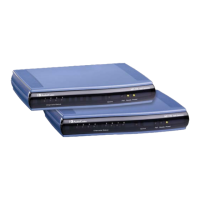SIP User's Manual 404 Document #: LTRT-65412
MP-11x & MP-124
Below is an example of media descriptions of an SDP indicating support for V.152.
v=0
o=- 0 0 IN IPV4 <IPAdressA>
s=-
t=0 0
p=+1
c=IN IP4 <IPAddressA
m=audio <udpPort A> RTP/AVP 18 0
a=ptime:10
a=rtpmap:96 PCMU/8000
a=gpmd: 96 vbd=yes
In the example above, V.152 implementation is supported (using the dynamic payload type
96 and G.711 u-law as the VBD codec) as well as the voice codecs G.711 μ-law and
G.729.
Instead of using VBD transport mode, the V.152 implementation can use alternative relay
fax transport methods (e.g., fax relay over IP using T.38). The preferred V.152 transport
method is indicated by the SDP ‘pmft’ attribute. Omission of this attribute in the SDP
content means that VBD mode is the preferred transport mechanism for voice-band data.
To configure T.38 mode, use the CoderName parameter.
9.6 FXO Operating Modes
This section provides a description of the device's FXO operating modes:
IP-to-Tel calls (refer to ''FXO Operations for IP-to-Tel Calls'' on page 404)
Tel-to-IP calls (refer to ''FXO Operations for Tel-to-IP
Calls'' on page 407)
9.6.1 FXO Operations for IP-to-Tel Calls
The FXO device provides the following operating modes for IP-to-Tel calls:
One-stage dialing (refer to ''One-Stage Dialing'' on page 405)
• Waiting for di
al tone ''Two-Stage Dialing'' on page 406
• Time to wait before di
aling
• Answer supervision
Two-stage dialing (refer to ''Two-Stage Dialing'' on page 406)
Dialing time
• Disconnect supervision (refer to ''Call Termination (Disconnect Supervision) on
FXO Devices'' on page 410)
• DID wi
nk (refer to ''DID Wink'' on page 407)

